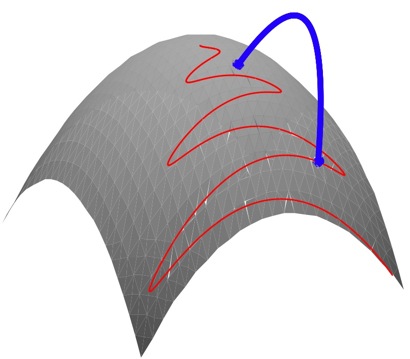All this trouble for one little Geococcyx californianus
Wile E. Coyote
Bleached Bones, AZ 59055
February 6, 2009
Math 236 Students
Wheaton College
Norton, MA 02766
Dear Multivariable Calculus Students:
The pain, the agony, the frustration have finally gotten to be too much. That @!*^@#! Roadrunner is really starting to get on my nerves. After all these years of trying and failing with mail-order solutions, I was able to snag some TARP funds last fall and hired an outside consultant, ACME Surveying and Parametrization Services, Ltd (ACME SPS), to help me devise a plan to catch the Roadrunner. Unfortunately, ACME SPS used my payments to help pay for their advertising campaign during the Super Bowl before they had completed my task. With the additional oversight requirements pending in the new administration, it seems unlikely that I will be able to tap the funds again. When I went looking for help in my endeavors, your enterprising and resourceful professor naturally referred me to you.
The basic plan is that I will capture the annoying bird by carefully hiding behind a rather sizable boulder on the side of a hill and launching an aerodynamically designed, teflon-coated, exploding-net pod (using the ACME Exploding-Net Pod Launcher, of course) set on a timer that will open immediately over the Roadrunner and drop the net onto the BEEP-BEEPING fowl as it comes speeding down the hill on the road at 50 m/s. Here's the basic idea:

This is where I need your help: I've already picked out the perfect place to hide and the ideal location to capture the Roadrunner, but I don't know the direction I should aim the launcher or the speed I should fire it. Your enterprising and resourceful professor suggested that perhaps a little more background is in order.
The crack consultants at ACME SPS have told me that the hill can be modeled fairly closely by the surface
where the positive y-axis points north, the positive x-axis points east, and the distances are measured in meters. Also, the road that the Roadrunner will be traveling on corresponds to the graph of
My perfect hiding place is a level area that is close to the point (50,30,783/2), and the spot to capture the dastardly bird is on the road very close to the point (150,97,320). Furthermore, because of the mismanagement at ACME SPS, I could only afford the ACME Exploding-Net Pod Launcher that launches the pod at an angle of 45 degrees to the horizontal.
One of the complicating factors in cartoon land that you may not be aware of is that gravity has not only a vertical component, but has southerly and westerly components as well. I'm a pretty smart carnivore, and I think I could adapt my launching technique to this, except that the horizontal components of gravity keep changing! You know the way there are tide tables that tell you when high tide and low tide are? Well, here we have gravity tables that tell us what the horizontal components of gravity will be on specific days. There is some consistency in that gravity is always pulling down at 9.8 m/s2, and the southerly and westerly components vary between 0, 2, and 4 m/s2.
My plan is to snag the scrawny little twerp on Saturday, February 21, when gravity will be pulling toward the west at 2 m/s2 and toward the south at 4 m/s2. What I need to know is the direction I should aim the launcher, the initial speed I should launch the pod, and how I should set the timer so that the pod will open just as it reaches the Roadrunner. I also, of course, need to know when I should launch the pod. Since I will have the opportunity to set this up ahead of time, I can place a marker on the side of the road so that I know to launch the pod at the instant the Roadrunner passes this marker on the way to the capture point.
I've been down this road enough times before (pun intended) to realize that everything may not go exactly as planned on the 26th. Since the gravity will not always be the same on other days, I also need the analysis done for the other possible values of the southerly and westerly components. That way, I'll be able to try my attack on another day without having to bother you again.
In order to give me time to fine tune my instruments of destruction, I will need your report by February 20. Please don't let me down. I'm getting really tired of this.
Yours sincerely,
Wile E. Coyote
A Few Comments From Your Enterprising and Resourceful Professor
After reading Wile E. Coyote's sad tale, I have a small suggestion that might help you get started. You may want to find an equation for the path of the exploding-net pod in terms of time t, the initial speed s, and the direction of the initial launch theta, measured as an angle north of east. And don't be afraid to use Maple's solve( ) command.